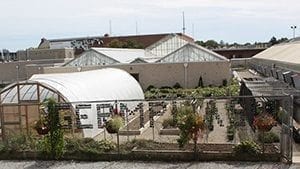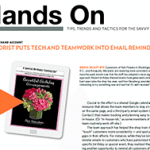
The Ornamental Plant Germplasm Center at Ohio State maintains a collection of about 4,200 accessions — a term used to describe the particular collection of a species — 220 genera, and 1,050 species of herbaceous ornamentals that are distributed to investigators, breeders, and educators worldwide upon request.
An important research center that the Society of American Florists helped found has received positive press in a popular trade magazine.
In the December 2015 issue of Nursery Management magazine, writer Matt McClellan turned his attention to the Ornamental Plant Germplasm Center at Ohio State. SAF was one of several groups involved in the launch of the center, which continues to receive funds through the U.S. Department of Agriculture’s Floriculture and Nursery Research Initiative.
“Nestled in an unassuming part of The Ohio State University’s campus, a small staff of four full-time employees and several student volunteers and interns maintain the United States’ depository of plant material for six herbaceous plants,” writes McClellan. “The center’s focus: Phlox, coreopsis, lillium, rudbeckia, begonia and viola.”
The center maintains a collection of about 4,200 accessions — a term used to describe the particular collection of a species — 220 genera, and 1,050 species of herbaceous ornamentals that are distributed to investigators, breeders, and educators worldwide upon request. The majority of these accessions are conserved as seed in its own seed vault.
“Our purpose first and foremost, is to make germplasm available to the industry,” said the center’s director, Pablo Jourdan, an associate professor in OSU’s Department of Horticulture and Crop Science. (Plant germplasm, as McClellan notes, “is living tissue from which new plants can be grown. It can be a seed, a leaf, a stem, pollen or just a few cells that can be cultured into a new plant.”)
“Some of it involves maintenance activities like making sure we have seeds that are in good condition,” Jourdan explained, “and making sure we have the material people are interested in available, and making sure the collection we have is in good shape.”
According to McClellan, “the National Plant Germplasm System stores and catalogs germplasm of plants that might otherwise be lost. Each plant receives a number, and is catalogued in the system. Many varieties are passed down through the generations like a grandfather’s watch or other treasured heirloom. Plant Introduction No. 1 is a cabbage variety introduced from Russia in 1898. … there are 20 similar facilities, scattered throughout the U.S., including the Ornamental Plant Germplasm Center in Columbus, Ohio.”
“Until was established, there was no federal facility devoted to preserving the germplasm of herbaceous ornamentals,” explained Lin Schmale, SAF’s senior director of government relations. “So, varieties of plants and flowers that once were popular, or which existed in the wild, might be lost. With the OPGC, companies or breeders can go to the center and receive germ plasm of plants/flowers that they want to work with.”
This isn’t the first time the Center has drawn attention in the press for its impressive work. An article in the Aug. 16 Columbus Dispatch told the story of the center’s contribution to the preservation and propagation of a rare and endangered plant in central Ohio, Arabis patens, or rock cress.
The Floriculture and Nursery Research Initiative funds research, conducted by USDA’s Agricultural Research Service and university scientists, of importance to the floral and horticultural industry that is strongly focused on addressing and solving the industry’s issues and needs. ARS works closely with representatives of the American Nursery and Landscape Association and the Society of American Florists in setting the research priorities and goals of this Initiative. Find out more.



